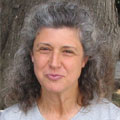 The End of Our Cruise
The End of Our Cruise
PUNTA ARENAS, CHILE-- Late last night we arrived at Punta Arenas, Chile. This marks the end of our Iceberg 3 cruise. We have finished analyzing the samples, re-calibrating instruments and we are now ready to start packing... {Read More »}

 Maria Vernet is a marine scientist from Scripps Institution of Oceanography at the University of California, San Diego. She has participated in various studies involving phytoplankton ecology and physiology including the effects of ultraviolet radiation on photosynthesis to the grazing by Antarctic krill on coastal phytoplankton. During
Maria Vernet is a marine scientist from Scripps Institution of Oceanography at the University of California, San Diego. She has participated in various studies involving phytoplankton ecology and physiology including the effects of ultraviolet radiation on photosynthesis to the grazing by Antarctic krill on coastal phytoplankton. During 







